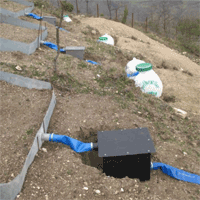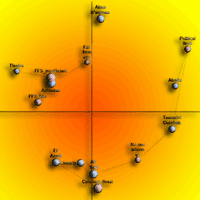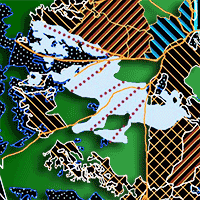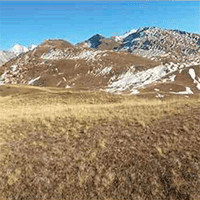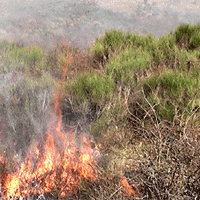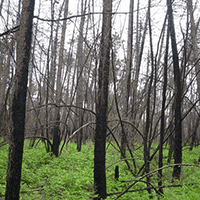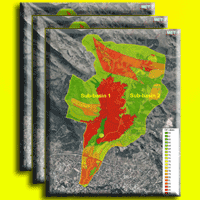
Effects of wildfires on peak discharges in watersheds
Maurizio Leopardi, Anna Rita Scorzini
iForest - Biogeosciences and Forestry, Volume 8, Issue 3, Pages 302-307 (2015)
doi: https://doi.org/10.3832/ifor1120-007
Published: Sep 03, 2014 - Copyright © 2015 SISEF
Technical Reports
Abstract
Wildfires can alter the hydrological processes in watersheds resulting in increases in peak discharge - one of the most important hydrological variables used in water resources applications. It thus follows that the standard methods used to calculate rainfall runoff should be modified in order to model the potential changes in watershed response under post-fire conditions. However, no reliable methodology for quantitatively assessing the effects of wildfires on hydrological parameters, such as curve numbers or runoff coefficients, has been identified to date. The approaches currently used are usually site-specific, mainly based on personal experience or very simple empirical strategies and then affected by a degree of uncertainty. This paper addresses issues regarding the estimation of the Soil Conservation Service Curve Number (SCS-CN or CN) and considers the case study of San Giuliano, L’Aquila (Italy), a small urban basin recently affected by a wildfire that resulted in a significant reduction in forest cover. The effects of the fire on runoff are modelled by adjusting CNs according to existing approaches from the literature in order to perform a sensitivity analysis for post-fire conditions; this allows us to examine the effects of the variability in model input parameters (estimates of post-fire CNs) upon expected peak discharges related to different return period storms. The fire effect ratio, which can be seen as a global parameter for describing alterations in the watershed response due to fire, is calculated by dividing post-fire peak discharge by pre-fire peak discharge. For the present case study, this ratio ranged between 1.1 and 2.3, indicating the urgent need for quantitative research on the effects of wildfires on the hydrological variables affecting runoff calculations.
Keywords
Authors’ Info
Authors’ address
Anna Rita Scorzini
Dipartimento di Ingegneria Civile, Edile-Architettura e Ambientale, Università degli Studi dell’Aquila, v. G. Gronchi 18, I-67100 L’Aquila (Italy)
Corresponding author
Paper Info
Citation
Leopardi M, Scorzini AR (2015). Effects of wildfires on peak discharges in watersheds. iForest 8: 302-307. - doi: 10.3832/ifor1120-007
Academic Editor
Luca Salvati
Paper history
Received: Sep 09, 2013
Accepted: May 25, 2014
First online: Sep 03, 2014
Publication Date: Jun 01, 2015
Publication Time: 3.37 months
Copyright Information
© SISEF - The Italian Society of Silviculture and Forest Ecology 2015
Open Access
This article is distributed under the terms of the Creative Commons Attribution-Non Commercial 4.0 International (https://creativecommons.org/licenses/by-nc/4.0/), which permits unrestricted use, distribution, and reproduction in any medium, provided you give appropriate credit to the original author(s) and the source, provide a link to the Creative Commons license, and indicate if changes were made.
Web Metrics
Breakdown by View Type
Article Usage
Total Article Views: 53896
(from publication date up to now)
Breakdown by View Type
HTML Page Views: 44281
Abstract Page Views: 3929
PDF Downloads: 4235
Citation/Reference Downloads: 21
XML Downloads: 1430
Web Metrics
Days since publication: 4104
Overall contacts: 53896
Avg. contacts per week: 91.93
Citation Metrics
Article Citations
Article citations are based on data periodically collected from the Clarivate Web of Science web site
(last update: Mar 2025)
Total number of cites (since 2015): 16
Average cites per year: 1.45
Publication Metrics
by Dimensions ©
Articles citing this article
List of the papers citing this article based on CrossRef Cited-by.
References
Fire effects on water supply, floods, and sedimentation. In: Proceedings of the “15th Annual Tall Timbers Fire Ecology Conference: Pacific Northwest”. Portland (OR, USA) 16-17 Oct 1974. Tall Timbers Research Inc., Tallahassee, FL, USA, pp. 249-260.
Gscholar
Changes in the hydrological response of two Sicilian basins affected by fire. In: Proceedings of the “4th International FRIEND Conference”. Cape Town (South Africa) 18-22 March 2002. IAHS Publ. no. 274, pp. 163-169.
Gscholar
Recovery of a New Mexico drainage basin from a forest fire. In: Proceedings of the “Vancouver Symposium, Forest Hydrology and Watershed Management”. Vancouver (BC, Canada) 9-22 Aug 1987. IAHS-AISH Publ. no. 167, pp. 191-198.
Gscholar
Wildfire effects on a ponderosa pine ecosystem: an Arizona case study. Research Paper RM-191, Rocky Mountain Research Station, USDA Forest Service, Fort Collins, CO, USA, pp. 12.
Gscholar
Application of models to predict post-fire runoff and sediment transport at the watershed scale in southwestern forests. In: Proceedings of the “2005 Watershed Management Conference - Managing Watersheds for Human and Natural Impacts: Engineering, Ecological, and Economic Challenges” (Moglen GE ed). American Society of Civil Engineers, Reston, VA, USA, pp. 1-12.
Gscholar
A synthesis of post-fire road treatments for BAER teams: methods, treatment effectiveness, and decision making tools for rehabilitation. Gen. Tech. Rep. RMRS-GTR-228, Rocky Mountain Research Station, USDA Forest Service, Fort Collins, CO, USA, pp. 152.
Gscholar
Previsione delle piene e delle magre dei corsi d’acqua [Estimation of flood and drought discharges in natural streams]. Istituto Poligrafico dello Stato 8: 107-117. [in Italian]
Gscholar
Salt Creek BAER-2007 burned area emergency response. Hydrology Specialist Report, Uinta National Forest, Provo, UT, USA, pp. 11.
Gscholar
Los Alamos post-fire watershed recovery: a curve-number-based evaluation. In: Proceedings of the “2005 Watershed Management Conference - Managing Watersheds for Human and Natural Impacts: Engineering, Ecological, and Economic Challenges” (Moglen GE ed). American Society of Civil Engineers, Reston, VA, USA, pp. 471-481.
CrossRef | Gscholar
Post-wildfire watershed flood responses. In: Procedings of the “2nd International Fire Ecology and Fire Management Congress”. Orlando (Florida) 16-20 Nov 2003. Paper 1B7, pp. 1-7.
Gscholar
Hydrologic analysis used to determine effects of fire on peak discharge and erosion rates in Southern California watersheds. USDA Water Resources Center Archives, University of California, Berkeley, CA, USA, pp. 49.
Gscholar
Curve number and peakflow responses following the Cerro Grande fire on a small watershed. In: Proceedings of the “2005 Watershed Management Conference - Managing Watersheds for Human and Natural Impacts: Engineering, Ecological, and Economic Challenges” (Moglen GE ed). American Society of Civil Engineers, Reston, VA, USA, pp. 459-470.
CrossRef | Gscholar
Urban hydrology for small watersheds. Technical Release 55, USDA, Washington, DC, USA, pp. 164.
Gscholar



